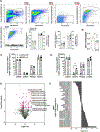Early life stress exacerbates obesity in adult female mice via mineralocorticoid receptor-dependent increases in adipocyte triglyceride and glycerol content
- PMID: 35714704
- PMCID: PMC10987253
- DOI: 10.1016/j.lfs.2022.120718
Early life stress exacerbates obesity in adult female mice via mineralocorticoid receptor-dependent increases in adipocyte triglyceride and glycerol content
Abstract
Previously, we have shown that Maternal Separation and Early Weaning (MSEW) exacerbates high fat diet (HF)-induced visceral obesity in female offspring compared to normally reared female mice. Stress hormones such as glucocorticoids and mineralocorticoids are critical mediators in the process of fat expansion, and both can activate the mineralocorticoid receptor (MR) in the adipocyte. Therefore, this study aimed to, comprehend the specific effects of MSEW on adipose tissue basic homeostatic function, and investigate whether female MSEW mice show an exacerbated obesogenic response mediated by MR. Gonadal white adipose tissue (gWAT), a type of visceral fat, was collected to assess lipidomics, transcriptomics, and in vitro lipolysis assay. Obese female MSEW mice showed increased adiposity, elevated 44:2/FA 18:2 + NH4 lipid class and reduced mitochondrial DNA density compared to obese control counterparts. In addition, single-cell RNA sequencing in isolated pre- and mature adipocytes showed a ~9-fold downregulation of aquaglycerolporin 3 (Aqp3), a channel responsible for glycerol efflux in adipocytes. Obese MSEW mice showed high levels of circulating aldosterone and gWAT-derived corticosterone compared to controls. Further, the MR blocker spironolactone (Spiro, 100 mg/kg/day, 2 weeks) normalized the elevated intracellular glycerol levels, the greater in vitro lipolysis response, and the number of large size adipocytes in MSEW mice compared to the controls. Our data suggests that MR plays a role promoting adipocyte hypertrophy in female MSEW mice by preventing lipolysis via glycerol release in favor of triglyceride formation and storage.
Keywords: Adiposity; Early life stress; Lipidomics; Single cell RNA-seq; Spironolactone.
Copyright © 2022 Elsevier Inc. All rights reserved.
Conflict of interest statement
Figures





References
-
- Hales CM, Carroll MD, Fryar CD, Ogden CL. Prevalence of Obesity and Severe Obesity Among Adults: United States, 2017–2018. NCHS data brief 2020(360):1–8. - PubMed
-
- Felitti VJ, Anda RF, Nordenberg D, Williamson DF, Spitz AM, Edwards V, et al. Relationship of childhood abuse and household dysfunction to many of the leading causes of death in adults. The Adverse Childhood Experiences (ACE) Study. American journal of preventive medicine 1998;14(4):245–58. - PubMed
-
- Allen H, Wright BJ, Vartanian K, Dulacki K, Li H-F. Examining the Prevalence of Adverse Childhood Experiences and Associated Cardiovascular Disease Risk Factors Among Low-Income Uninsured Adults. Circ Cardiovasc Qual Outcomes 2019;12(9):e004391–e. - PubMed
MeSH terms
Substances
Grants and funding
LinkOut - more resources
Full Text Sources
Medical
Molecular Biology Databases
Research Materials
Miscellaneous

